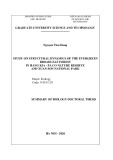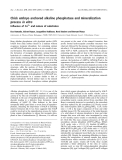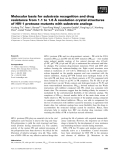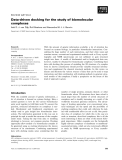
Nature structural biology
-
Objectives: Researching and analyzing the structure of Vietnamese general textbooks and textbooks of some other countries that have advanced education to build model of textbooks of Natural Science subject at the secondary school with specific criteria, contributing to renovation of teaching methods, implementation of educational reform to develop competencies and personalities of students, enhancement of Natural Science education quality.
 27p
27p  tunelove
tunelove
 10-06-2021
10-06-2021
 34
34
 5
5
 Download
Download
-
The research objectives of the thesis: Isolate and determine the chemical structure of compounds from C. candicans and C. macrophylla species collected in Vietnam. Assessment of toxic activity on some cancer cell lines: liver (Hep-G2), lung (Lu-1) and breast (MCF-7) of isolated clean compounds. Researching the chemical composition of C. candicans and C. macrophylla essential oils
 29p
29p  extraenglish
extraenglish
 24-05-2021
24-05-2021
 16
16
 4
4
 Download
Download
-
General objective: To contribute to understanding the rules and structural dynamics of evergreen broadleaf natural forests as a basis for proposing some solutions for sustainable forest management.
 27p
27p  capheviahe27
capheviahe27
 23-02-2021
23-02-2021
 11
11
 3
3
 Download
Download
-
The research goals of the dissertation: The research separates, identifies structural characteristics and tests biological activity of fucoidan from several brown algae growing up in Vietnamese Seas to serve for investigating Vietnamese natural sea compound resources and making clear the chemical nature of research objects.
 26p
26p  xacxuoc4321
xacxuoc4321
 09-07-2019
09-07-2019
 29
29
 6
6
 Download
Download
-
The aims of the dissertation are: Extracting and determining the structure of organic compounds of four plant species with potential for insecticide and fungal diseases. Isolating endogenous fungi from plant samples, extracting and determining the structure of component organic compounds. Testing of insecticidal and fungal activity of extracts and component organic compounds.
 35p
35p  xacxuoc4321
xacxuoc4321
 08-07-2019
08-07-2019
 33
33
 3
3
 Download
Download
-
In this review, we summarize recent progress in studying three main classes of prenyltransferases: (a) isoprenyl pyrophosphate synthases (IPPSs), which catalyze chain elongation of allylic pyrophosphate substrates via consecutive condensation reactions with isopentenyl pyrophosphate (IPP) to generate linear polymers with defined chain lengths; (b) protein prenyltransferases, which catalyze the transfer of an isoprenyl pyrophosphate (e.g. farnesyl pyrophosphate) to a protein or a peptide; (c) prenyltransferases, which catalyze the cyclization of isoprenyl pyrophosphates.
 16p
16p  research12
research12
 01-06-2013
01-06-2013
 49
49
 4
4
 Download
Download
-
a2 -Macroglobulin (a2M) is an abundant glycoprotein with the intrinsic capacity for capturing diverse proteins for rapid delivery into cells. After internalization by the receptor-mediated endocytosis,a2M-protein complexes were rapidly degraded in the endolysosome system. Although this is an importantpathway for clearanceofbotha2Mandbiological targets, little is known about the nature ofa2M degradation in the endolysosome system.
 10p
10p  tumor12
tumor12
 20-04-2013
20-04-2013
 33
33
 3
3
 Download
Download
-
Different pathways of bilayer disruption by the structurally related antimicrobial peptides cecropin B, B1 and B3, revealed by surface plasma resonance analysis of immobi-lized liposomes, differential scanning calorimetryof peptide– large unilamellar vesicle interactions, and light microscopic analysis of peptide-treated giant unilamellar vesicles, have been identified inthis study.
 10p
10p  tumor12
tumor12
 20-04-2013
20-04-2013
 39
39
 3
3
 Download
Download
-
To elucidate the structural features of the mussel defensin MGD1 required for antimicrobial activity, we synthesized a series of peptides corresponding to the main known secon-dary structures of the molecule and evaluated their activity towards Gram-positive and Gram-negative bacteria, and filamentous fungi. We found that the nonapeptide corres-ponding to residues 25–33 of MGD1 (CGGWHRLRC) exhibited bacteriostatic activity once it was cyclized by a non-naturally occurring disulfide bridge.
 9p
9p  fptmusic
fptmusic
 16-04-2013
16-04-2013
 47
47
 2
2
 Download
Download
-
Bone alkaline phosphatase with glycolipid anchor (GPI-bALP) from chick embryo femurs in a medium without exogenous inorganic phosphate,but containing calcium and GPI-bALP substrates,served asin vitro model of min-eral formation. The mineralization process was initiated by the formation of inorganic phosphate,arising from the hydrolysis of a substrate by GPI-bALP. Several minerali-zation media containing different substrates were analysed after an incubation time ranging from 1.5 h to 144 h.
 9p
9p  fptmusic
fptmusic
 16-04-2013
16-04-2013
 45
45
 2
2
 Download
Download
-
HIV-1 protease (PR) and two drug-resistant variants – PR with the V82A mutation (PRV82A) and PR with the I84V mutation (PRI84V) – were studied using reduced peptide analogs of five natural cleavage sites (CA-p2, p2-NC, p6 pol -PR, p1-p6 and NC-p1) to understand the structural and kine-tic changes. The common drug-resistant mutations V82A and I84V alter residues forming the substrate-binding site. Eight crystal structures were refined at resolutions of 1.10–1.60 A ˚ .
 13p
13p  fptmusic
fptmusic
 12-04-2013
12-04-2013
 38
38
 2
2
 Download
Download
-
With the amount of genetic information available, a lot of attention has focused on systems biology, in particular biomolecular interactions. Con-sidering the huge number of such interactions, and their often weak and transient nature, conventional experimental methods such as X-ray crystal-lography and NMR spectroscopy are not sufficient to gain structural insight into these. A wealth of biochemical and⁄or biophysical data can, however, readily be obtained for biomolecular complexes.
 20p
20p  awards
awards
 05-04-2013
05-04-2013
 46
46
 3
3
 Download
Download
-
Photosystem II (PSII), an essential component of oxygenic photosynthesis, is a membrane-bound pigment protein complex found in green plants and cyanobacteria. Whereas the molecular structure of cyanobacterial PSII has been resolved with at least medium resolution [Zouni, A., Witt, H.-T., Kern, J., Fromme, P., Krauss, N., Saenger, W. & Orth, P. (2001)Nature (London)409, 739–743; Kamiya, N. &Shen, J.R. (2003)Proc. Natl Acad. Sci. USA100, 98–103], the structure of higher plant PSII is only known at low resolution. ...
 5p
5p  dell39
dell39
 03-04-2013
03-04-2013
 44
44
 5
5
 Download
Download
-
We show a simple and reliable method of tRNA aminoacylation with natural, as well as non-natural, amino acids at high pressure. Such specific and noncognate tRNAs can be used as valuable substrates for protein engineering. Aminoacylation yield at high pressure depends on the chem-ical nature of the amino acid used and it is up to 10%.
 10p
10p  inspiron33
inspiron33
 25-03-2013
25-03-2013
 45
45
 3
3
 Download
Download
-
The 3D structure of a complex formed by the acidic fibroblast growth fac-tor (FGF-1) and a specifically designed synthetic heparin hexasaccharide has been determined by NMR spectroscopy. This hexasaccharide can sub-stitute natural heparins in FGF-1 mitogenesis assays, in spite of not indu-cing any apparent dimerization of the growth factor.
 12p
12p  inspiron33
inspiron33
 23-03-2013
23-03-2013
 37
37
 4
4
 Download
Download
-
The biochemical nature and the replication of infectious prions have been intensively studied in recent years. Much less is known about the cellular events underlying neuronal dysfunction and cell death. As the cellular func-tion of the normal cellular isoform of prion protein is not exactly known, the impact of gain of toxic function or loss of function, or a combination of both, in prion pathology is still controversial.
 6p
6p  galaxyss3
galaxyss3
 21-03-2013
21-03-2013
 57
57
 5
5
 Download
Download
-
Cystine-knot miniproteins are members of a large family of small proteins that are defined by a common structural scaffold which is stabilized by three intramolecular disulfide bonds. Cystine-knot miniproteins display a broad spectrum of therapeutically useful natural biological activities and several family members are marketed as therapeutics or are in clinical development.
 7p
7p  galaxyss3
galaxyss3
 07-03-2013
07-03-2013
 30
30
 4
4
 Download
Download
-
The ubiquitin–proteasome pathway is crucial for a variety of biological processes, including spermatogenesis. Ubiquitin C-terminal hydrolase-L1 (Uch-L1) is thought to associate with monoubiquitin to control ubiquitin levels. Here, we report the identification of Uch-L1 cDNA from the testis of the rice field eel, a natural sex reversal vertebrate, by using cDNA microarray analysis.
 8p
8p  media19
media19
 05-03-2013
05-03-2013
 37
37
 3
3
 Download
Download
-
Human 8-oxoguanine-DNA glycosylase (OGG1) efficiently removes muta-genic 8-oxo-7,8-dihydroguanine (8-oxoGua) and 2,6-diamino-4-hydroxy-5-formamidopyrimidine when paired with cytosine in oxidatively damaged DNA. Excision of 8-oxoGua mispaired with adenine may lead to GfiT transversions.
 14p
14p  vinaphone15
vinaphone15
 25-02-2013
25-02-2013
 41
41
 3
3
 Download
Download
-
One of the most important pathological features of type 2 diabetes is the formation of islet amyloid, of which the major component is amylin pep-tide. However, the presence of a natural inhibitor such as insulin may keep amylin stable and physiologically functional in healthy individuals. Some previous studies demonstrated that insulin was a potent inhibitor of amylin fibril formationin vitro, but others obtained contradictory results.
 7p
7p  viettel02
viettel02
 22-02-2013
22-02-2013
 41
41
 3
3
 Download
Download
CHỦ ĐỀ BẠN MUỐN TÌM

































